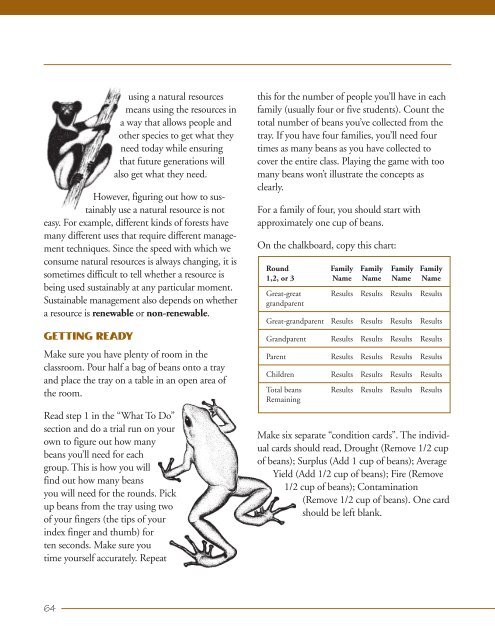EXPLORING BIODIVERSITY: A Guide for Educators Around the World
EXPLORING BIODIVERSITY: A Guide for Educators Around the World
EXPLORING BIODIVERSITY: A Guide for Educators Around the World
Create successful ePaper yourself
Turn your PDF publications into a flip-book with our unique Google optimized e-Paper software.
using a natural resources<br />
means using <strong>the</strong> resources in<br />
a way that allows people and<br />
o<strong>the</strong>r species to get what <strong>the</strong>y<br />
need today while ensuring<br />
that future generations will<br />
also get what <strong>the</strong>y need.<br />
However, figuring out how to sustainably<br />
use a natural resource is not<br />
easy. For example, different kinds of <strong>for</strong>ests have<br />
many different uses that require different management<br />
techniques. Since <strong>the</strong> speed with which we<br />
consume natural resources is always changing, it is<br />
sometimes difficult to tell whe<strong>the</strong>r a resource is<br />
being used sustainably at any particular moment.<br />
Sustainable management also depends on whe<strong>the</strong>r<br />
a resource is renewable or non-renewable.<br />
GETTING READY<br />
Make sure you have plenty of room in <strong>the</strong><br />
classroom. Pour half a bag of beans onto a tray<br />
and place <strong>the</strong> tray on a table in an open area of<br />
<strong>the</strong> room.<br />
Read step 1 in <strong>the</strong> “What To Do”<br />
section and do a trial run on your<br />
own to figure out how many<br />
beans you’ll need <strong>for</strong> each<br />
group. This is how you will<br />
find out how many beans<br />
you will need <strong>for</strong> <strong>the</strong> rounds. Pick<br />
up beans from <strong>the</strong> tray using two<br />
of your fingers (<strong>the</strong> tips of your<br />
index finger and thumb) <strong>for</strong><br />
ten seconds. Make sure you<br />
time yourself accurately. Repeat<br />
this <strong>for</strong> <strong>the</strong> number of people you’ll have in each<br />
family (usually four or five students). Count <strong>the</strong><br />
total number of beans you’ve collected from <strong>the</strong><br />
tray. If you have four families, you’ll need four<br />
times as many beans as you have collected to<br />
cover <strong>the</strong> entire class. Playing <strong>the</strong> game with too<br />
many beans won’t illustrate <strong>the</strong> concepts as<br />
clearly.<br />
For a family of four, you should start with<br />
approximately one cup of beans.<br />
On <strong>the</strong> chalkboard, copy this chart:<br />
Round Family Family Family Family<br />
1,2, or 3 Name Name Name Name<br />
Great-great Results Results Results Results<br />
grandparent<br />
Great-grandparent Results Results Results Results<br />
Grandparent Results Results Results Results<br />
Parent Results Results Results Results<br />
Children Results Results Results Results<br />
Total beans Results Results Results Results<br />
Remaining<br />
Make six separate “condition cards”. The individual<br />
cards should read, Drought (Remove 1/2 cup<br />
of beans); Surplus (Add 1 cup of beans); Average<br />
Yield (Add 1/2 cup of beans); Fire (Remove<br />
1/2 cup of beans); Contamination<br />
(Remove 1/2 cup of beans). One card<br />
should be left blank.<br />
64

















